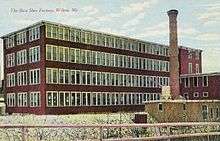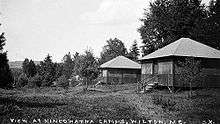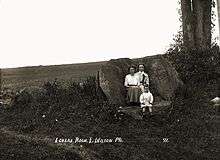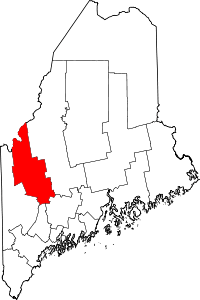Wilton, Maine
| Wilton, Maine | |
|---|---|
| Town | |
|
| |
| Motto: A great place to live, work & play | |
 Wilton Location within the state of Maine | |
| Coordinates: 44°36′59″N 70°14′37″W / 44.61639°N 70.24361°WCoordinates: 44°36′59″N 70°14′37″W / 44.61639°N 70.24361°W | |
| Country | United States |
| State | Maine |
| County | Franklin |
| Incorporated | 1803 |
| Area[1] | |
| • Total | 42.82 sq mi (110.90 km2) |
| • Land | 41.26 sq mi (106.86 km2) |
| • Water | 1.56 sq mi (4.04 km2) |
| Elevation | 425 ft (130 m) |
| Population (2010)[2] | |
| • Total | 4,116 |
| • Estimate (2012[3]) | 4,076 |
| • Density | 99.8/sq mi (38.5/km2) |
| Time zone | Eastern (EST) (UTC-5) |
| • Summer (DST) | EDT (UTC-4) |
| ZIP code | 04294 (Wilton), 04234 (East Wilton), 04227 (Dryden) |
| Area code(s) | 207 |
| Website | www.wiltonmaine.org |
Wilton is a town in Franklin County, Maine, United States. The population was 4,116 at the 2010 census. Situated beside Wilson Pond, the former mill town is today primarily a recreation area.
History
The land replaced an invalidated 1727 grant by Massachusetts to veterans for service in the French and Indian Wars.[4] The first grant (now part of Manchester, New Hampshire) was originally dubbed Harrytown after a particularly dangerous Native American,[5] then renamed Tyngstown for Captain William Tyng, leader of the expedition of "snowshoe men" that killed him in 1703.[6] Abraham Butterfield, a settler from Wilton, New Hampshire, paid the cost of incorporation in 1803 to have the new town named after his former residence.[7]
Wilton is known for being the location of Maine's first cotton mill, started in 1810 by Solomon Adams.[8] In 1876, George Henry Bass (1855–1925) founded G.H. Bass & Co. and became the best-known businessman in Wilton's history. Bass shoes (including those worn by Charles Lindbergh during his Atlantic crossing and Admiral Byrd in his expeditions to Antarctica) were made exclusively in Wilton for more than a century until 1998. By then the Bass family had sold out,[9] and in 1998 Bass' parent company, Phillips-Van Heusen, moved operations overseas.
John Russell Bass (b. 1878), son of G. H. Bass, was treasurer for the firm and served as Maine delegate to the Republican national convention in 1920, 1944 and 1952. The company built much of its success on the Bass penny weejun, introduced in 1936 and said to be based on Norwegian fisherman's shoes. The style was an instant hit, and became a staple on college campuses across the nation. The shoe was later renamed the Leavitt penny weejun; it is no longer made in Wilton.[10]
Maine architect John Calvin Stevens designed the L. Brooks Leavitt home in Wilton. Stevens was the architect of many well-known Maine residences, including Winslow Homer's in Prouts Neck, Maine.[11] An early Wall Street investment banker and rare book collector, Brooks Leavitt was an overseer and financial supporter of Bowdoin College and its library, and a relation of the Bass family.[12] Esteemed Maine author Robert P.T. Coffin dedicated his book Captain Abby and Captain John to lifelong friend Leavitt, "a fellow son of Maine," whom Coffin eulogized in his poem "Brooks Leavitt," read at Leavitt's 1948 funeral in Wilton. A longtime patron of the arts, Brooks Leavitt was close to many New York artists and actors, including Francis Wilson, the foremost Broadway stage actor of his day.[13]
Other historic buildings in Wilton include the Goodspeed Memorial Library and the Bass Boarding House, both of which are listed on the National Register of Historic Places.
 High Street in 1905
High Street in 1905 East Wilton depot in 1919
East Wilton depot in 1919 Bass shoe factory in 1914
Bass shoe factory in 1914 Wilson Lake in 1914
Wilson Lake in 1914
Geography
According to the United States Census Bureau, the town has a total area of 42.82 square miles (110.90 km2), of which, 41.26 square miles (106.86 km2) of it is land and 1.56 square miles (4.04 km2) is water.[1] Home to Wilson Lake (or Pond), Wilton is drained by Wilson Stream, a tributary of the Sandy River, in the Kennebec River watershed. The southwestern corner of town lies within the watershed of the Androscoggin River.
The town is crossed by U.S. Route 2 and state routes 4, 17, 133 and 156. It borders the towns of Farmington to the east, Carthage to the west, Temple to the north, and Jay to the south.
Demographics
| Historical population | |||
|---|---|---|---|
| Census | Pop. | %± | |
| 1810 | 770 | — | |
| 1820 | 1,115 | 44.8% | |
| 1830 | 1,640 | 47.1% | |
| 1840 | 2,198 | 34.0% | |
| 1850 | 1,909 | −13.1% | |
| 1860 | 1,920 | 0.6% | |
| 1870 | 1,906 | −0.7% | |
| 1880 | 1,739 | −8.8% | |
| 1890 | 1,622 | −6.7% | |
| 1900 | 1,647 | 1.5% | |
| 1910 | 2,143 | 30.1% | |
| 1920 | 2,505 | 16.9% | |
| 1930 | 3,266 | 30.4% | |
| 1940 | 3,228 | −1.2% | |
| 1950 | 3,455 | 7.0% | |
| 1960 | 3,274 | −5.2% | |
| 1970 | 3,802 | 16.1% | |
| 1980 | 4,382 | 15.3% | |
| 1990 | 4,242 | −3.2% | |
| 2000 | 4,123 | −2.8% | |
| 2010 | 4,116 | −0.2% | |
| Est. 2014 | 3,999 | [14] | −2.8% |

2010 census
As of the census[2] of 2010, there were 4,116 people, 1,708 households, and 1,152 families residing in the town. The population density was 99.8 inhabitants per square mile (38.5/km2). There were 2,025 housing units at an average density of 49.1 per square mile (19.0/km2). The racial makeup of the town was 96.3% White, 0.6% African American, 0.4% Native American, 0.9% Asian, 0.1% from other races, and 1.6% from two or more races. Hispanic or Latino of any race were 0.9% of the population.
There were 1,708 households of which 30.3% had children under the age of 18 living with them, 50.6% were married couples living together, 11.2% had a female householder with no husband present, 5.6% had a male householder with no wife present, and 32.6% were non-families. 25.8% of all households were made up of individuals and 10.8% had someone living alone who was 65 years of age or older. The average household size was 2.41 and the average family size was 2.84.
The median age in the town was 43.2 years. 23.3% of residents were under the age of 18; 6.8% were between the ages of 18 and 24; 22.4% were from 25 to 44; 30.9% were from 45 to 64; and 16.7% were 65 years of age or older. The gender makeup of the town was 49.3% male and 50.7% female.
2000 census
As of the census[16] of 2000, there were 4,123 people, 1,667 households, and 1,148 families residing in the town. The population density was 99.9 people per square mile (38.6/km²). There were 1,882 housing units at an average density of 45.6 per square mile (17.6/km²). The racial makeup of the town was 97.45% White, 0.44% Black or African American, 0.39% Native American, 0.80% Asian, 0.10% from other races, and 0.82% from two or more races. Hispanic or Latino of any race were 0.44% of the population.
There were 1,667 households out of which 31.7% had children under the age of 18 living with them, 54.2% were married couples living together, 11.0% had a female householder with no husband present, and 31.1% were non-families. 24.9% of all households were made up of individuals and 10.7% had someone living alone who was 65 years of age or older. The average household size was 2.47 and the average family size was 2.94.

In the town the population was spread out with 26.1% under the age of 18, 7.5% from 18 to 24, 27.0% from 25 to 44, 26.1% from 45 to 64, and 13.3% who were 65 years of age or older. The median age was 39 years. For every 100 females there were 93.2 males. For every 100 females age 18 and over, there were 89.6 males.
The median income for a household in the town was $34,563, and the median income for a family was $42,679. Males had a median income of $32,175 versus $20,300 for females. The per capita income for the town was $17,702. About 5.6% of families and 10.4% of the population were below the poverty line, including 10.2% of those under age 18 and 9.8% of those age 65 or over.
Education

There are two public elementary schools in Wilton: the Gerald D. Cushing School, for grades K-2, and the Academy Hill School, for grades 3-6. Total student population is approximately 300. They are part of MSAD 9.
Notable people
- David Chamberlain, cross-country skier
- Kathy Lynn Emerson, writer
- Ray Lamontagne, singer
- L. Brooks Leavitt, investment banker, antiquarian book collector
- Tom Saviello, state legislator
- Alpheus Beede Stickney, railway president
References
- 1 2 "US Gazetteer files 2010". United States Census Bureau. Retrieved 2012-12-16.
- 1 2 "American FactFinder". United States Census Bureau. Retrieved 2012-12-16.
- ↑ "Population Estimates". United States Census Bureau. Retrieved 2013-07-06.
- ↑ Coolidge, Austin J.; John B. Mansfield (1859). A History and Description of New England. Boston, Massachusetts. pp. 355–357.
- ↑ Varney, George J. (1886), Gazetteer of the state of Maine. Wilton, Boston: Russell
- ↑ History of Farmington, Maine, from Its First Settlement to 1846, Thomas Parker, J.S. Swift, Farmington, Maine, 1875
- ↑ Maine League of Historical Societies and Museums (1970). Doris A. Isaacson, ed. Maine: A Guide 'Down East'. Rockland, Me: Courier-Gazette, Inc. pp. 284–285.
- ↑ http://www.wiltonmaine.org/workers.html
- ↑ The Bass family sold G. H. Bass & Co. to the conglomerate Chesebrough-Pond's for $27 million in 1978.
- ↑ Made in America: From Levi's to Barbie to Google, Nick Freeth, 2005
- ↑ Drawing of Leavitt Residence, Wilton, ca. 1925, Maine Memory Network mainememory.net
- ↑ An early partner at Paine, Webber & Co., Leavitt donated to Bowdoin College early manuscripts by Bowdoin alumni Nathaniel Hawthorne and Henry Wadsworth Longfellow.
- ↑ Correspondence between Francis Wilson and L. Brooks Leavitt, Francis Wilson papers, The New York Public Library, Billy Rose Theater Division, npl.org
- ↑ "Annual Estimates of the Resident Population for Incorporated Places: April 1, 2010 to July 1, 2014". Retrieved June 4, 2015.
- ↑ "Census of Population and Housing". Census.gov. Retrieved June 4, 2015.
- ↑ "American FactFinder". United States Census Bureau. Retrieved 2008-01-31.
External links
| Wikimedia Commons has media related to Wilton, Maine. |
- Town of Wilton, Maine
- Wilton Free Public Library
- Wilton Farm & Home Museum
- Wilton Blueberry Festival
- Woodland Wanderers Snowmobile Club
- Franklin County Chamber of Commerce
